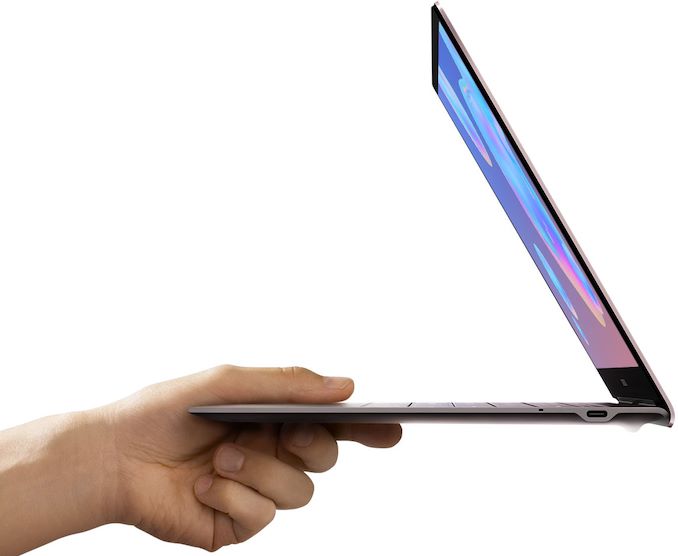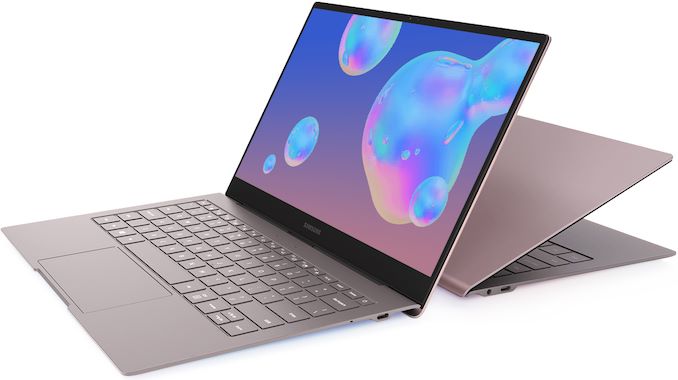Samsung Develops Intel Lakefield-Based Galaxy Book S: Always-Connected x86 PC
by Anton Shilov on October 31, 2019 1:00 PM EST- Posted in
- Notebooks
- Intel
- Samsung
- Laptops
- Galaxy Book
- Lakefield
- Galaxy Book S

Among several items at its developers conference this week, Samsung revealed that it was working on a version of its always-connected Galaxy Book S laptop powered by Intel’s Lakefield processor. When it becomes available in 2020, the notebook is expected to be the first mobile PC powered by Intel’s hybrid SoC, which containing a mix of high-performance and energy-efficient cores.
There are many laptop users nowadays who want their PCs to be very sleek, offer decent performance, be always connected to the Internet, and to last for a long time on a charge. Modern premium x86-based notebooks are very compact and can be equipped with a 4G/LTE modem, but even configured properly, the extra radio brings a hit to battery life over a non-modem model. The immediate solution is of course to use Intel’s low-power/energy-efficient Atom SoCs or Qualcomm's Snapdragon processors tailored for notebooks, but this will have an impact on performance.
To offer both performance and energy efficiency for always-connected notebooks, Intel has developed its Lakefield SoC that features one high-performance Ice Lake core, four energy-efficient Tremont cores, as well as Gen 11 graphics & media cores. Internally, Intel’s Lakefield consists of two dies — a 10 nm Compute die and a 14 nm Base die — integrated into one chip using the company’s Foveros 3D packaging technology to minimize its footprint. Courtesy of Foveros, the chip measures 12×12 mm and can be integrated into a variety of emerging always-connected devices.
As it turns out, Samsung’s upcoming version of the 13.3-inch Galaxy Book S will be the first to use Intel’s Lakefield, where it will be paired with Intel’s 4G/LTE modem to offer Internet connectivity everywhere.
Samsung is not disclosing pricing or availability details for its Lakefield-powered Galaxy Book S; but since Intel plans to start production of the SoC this quarter, expect the machine to launch in 2020.
Related Reading:
- Samsung Announces Always-Connected Galaxy Book S Laptop with Snapdragon 8cx
- Samsung Unveils Galaxy Book2: 12-Inch, Snapdragon 850 with X20 LTE, 20 Hrs
- Hands-On with Industry’s First 5G Laptop: A Lenovo with Qualcomm’s 8cx SoC and X55 Modem
- Qualcomm Tech Summit, Day 3: Snapdragon 8cx, the New ACPC SoC
- Spotted: Qualcomm Snapdragon 8cx Wafer on 7nm
- Lenovo Announces Yoga C630: The First Windows on Snapdragon 850
- Huawei Readies Windows 10 Laptop Based on Qualcomm Snapdragon 850
Source: Intel/Samsung












29 Comments
View All Comments
Hardware Geek - Saturday, November 2, 2019 - link
Oh, I'm definitely not trying to say Intel's foveros is better although ot may be, we simply don't know yet. That being said, I thought it was a really smart move on the part of AMD to use chiplets.Teckk - Saturday, November 2, 2019 - link
And AMD is dependent on TSMC on this though. Will be interesting to see their packaging advancements although Intel if it gets its 7nm right, would be the one to watch, based on how good it was, before 10nm.Hardware Geek - Saturday, November 2, 2019 - link
That's definitely a valid concern! The demand for 7nm has been far higher than TSMC anticipated.Quantumz0d - Friday, November 1, 2019 - link
Fantastic I/O options there right ?, thin as a wafer. Battery sealed inside so that you will buy the service and dump your machine to them once 2 years have passed or the as usual retarded culture of throwing it and buying a new soldered trash again.Kudos to Apple to achieve the market destruction from powerful notebook/laptop machines to thin and light fancy BS of form over function.
Typing this from a Haswell rPGA socket machine which was shipped with a Kepler now running Maxwell to Pascal soon. Yeah GPU upgrades with MXM (Dead now, since 10 series MXM was mutilated by last supporters - Clevo/Sager and MSI and Dell kicked the bucket with their own proprietary DGFF BS while HP use the one which dont have BIOS chips on the PCB making them useless on any MXM machine with standard form factor.
rrinker - Friday, November 1, 2019 - link
I don't know what you people do to your phones and laptops that the batteries are shot and won;t hold a charge after 2 years or less. I just recently finally upgraded from my iPhone 5S, which I got a few months after release (after the initial clamor of the "gotta have it on day 1" died off so I could walk in a store and walk out with a phone instead of being told they were out of stock and waiting for more), as it had FINALLY started not holding a charge as long as it originally did - over 5 years old. I've had previous one for a long time as well, and none of them were having battery issues at the time they got replaced, the 5S is the longest I held on to one, but prior to that I was always skipping a model or two.The only laptop I have is my work one, which is a couple of years old now, an HP, the battery still lasts as long as it did when I first got it, even though I run it plugged in 99% of the time. This is not an ultra-thin machine though, the bottom comes off and the battery can be replaced, it's not soldered or glued on. Neither is the RAM or the M.2 SSD. It's not a giant brick though, either.
phoenix_rizzen - Monday, November 18, 2019 - link
Trickly charge vs fast charge vs QuickCharge.Run battery to 0%, charge to 100%, repeat daily.
Stick it in a case that doesn't transfer heat very well.
If you baby the battery (trickly charge only, never below 20%, never about 80%, never overheat, etc), you can make it last for years and years and years.
Beat the crap out of the battery on a daily basis, and you'll be lucky to get 2 years out of it. My Galaxy S7 is on it's third battery now, just shy of the 4th year of ownership. But I'm hard on the battery. :D I like to actually use my phone for more than texting. :D
Wrong_again - Friday, November 1, 2019 - link
I need an OLED tablet with this please. Samsung is letting Microsoft run away with the high performance Windows 10 tablet/convertible market.HStewart - Friday, November 1, 2019 - link
There is better options for high performance tablets than Microsoft. Dell and Asus are better examples.A decade or so, I would say ThinkPad's, but Lenovo has messed it up but still not that bad if go high end.
abufrejoval - Tuesday, November 5, 2019 - link
I just wish they'd start using the big black bar below the display for more display instead of a logo.